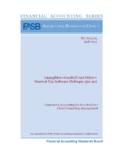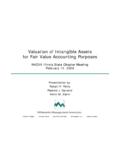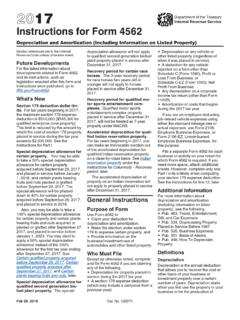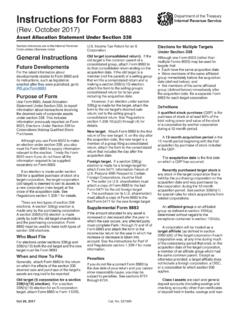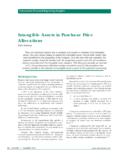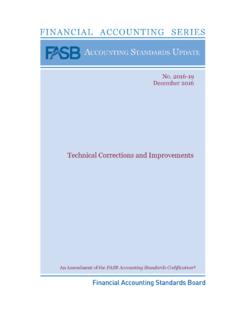Transcription of To the Point - EY
1 What you need to know The FASB proposed guidance that would eliminate the requirement to calculate the implied fair value of goodwill ( , Step 2 of today s goodwill impairment test) to measure a goodwill impairment charge. Instead, entities would record an impairment charge based on the excess of a reporting unit s carrying amount over its fair value ( , measure the charge based on today s Step 1). Comments are due by 11 July 2016. Overview The Financial Accounting Standards Board (FASB or Board) issued a proposal that would simplify the accounting for goodwill impairment for all entities by requiring an entity to record an impairment charge based only on the first step in today s two-step impairment test under Accounting Standards Codification (ASC) The FASB added this project to its agenda in response to feedback it received in 2014, when it issued an accounting alternative developed by the Private Company Council (PCC) that allows private companies2 to amortize goodwill and use a simpler one-step impairment At the time, the FASB asked whether it should allow other entities to apply the guidance in the alternative, and stakeholders expressed concerns about the cost and complexity of subsequently measuring goodwill for all entities.
2 No. 2016-26 12 May 2016 To the Point FASB proposed guidance Simplifying the accounting for goodwill impairment Entities would no longer have to perform Step 2 of the goodwill impairment test. EY AccountingLink | 2 | To the Point Simplifying the accounting for goodwill impairment 12 May 2016 In this project, the Board decided to focus first on simplifying the goodwill impairment test. In a future phase of the project, the FASB may consider other changes to the subsequent accounting for goodwill ( , amortization). Under today s impairment test, if the fair value of a reporting unit is lower than its carrying amount (Step 1), an entity calculates any impairment charge by comparing the implied fair value of goodwill with its carrying amount (Step 2). The implied fair value of goodwill is calculated by deducting the fair value4 of all assets and liabilities of the reporting unit from the reporting unit s fair value as determined in Step 1.
3 To determine the implied fair value of goodwill , entities estimate the fair value of any unrecognized intangible assets (including in-process research and development) and any corporate-level assets or liabilities that were included in the determination of the carrying amount and fair value of the reporting unit in Step 1. All of this makes Step 2 costly and complex. Key considerations Impairment test Under the proposal, if a reporting unit s carrying amount exceeds its fair value, an entity would record an impairment charge based on that difference. The impairment charge would be limited to the amount of goodwill allocated to that reporting unit. The proposal would eliminate today s requirement to calculate a goodwill impairment charge by comparing the implied fair value of goodwill with its carrying amount (Step 2) as described above. The proposal would not change the guidance on completing Step 1 of the goodwill impairment test.
4 An entity could still perform today s optional qualitative goodwill impairment assessment before determining whether to proceed to Step 1. Private companies would still have the option to elect the PCC alternative on goodwill . Reporting units with zero or negative carrying amounts Today, entities that have reporting units with zero or negative carrying amounts perform a qualitative assessment to determine whether to perform Step 2 of the goodwill impairment test. Under the proposal, entities with these reporting units would no longer be required to perform the qualitative assessment. As a result, reporting units with zero or negative carrying amounts would generally be expected to pass the simplified impairment test. However, those entities would have a new requirement to disclose any reporting units with zero or negative carrying amounts and the amount of goodwill allocated to those reporting units.
5 How we see it We support the FASB s efforts to simplify the accounting for goodwill impairment. The proposal may accelerate the timing of goodwill impairment charges. Under today's guidance, it is possible for a reporting unit to fail Step 1 but for goodwill not to be impaired based on how impairment is measured in Step 2. Transition and effective date The proposed guidance would be applied prospectively to goodwill impairment tests performed after the effective date ( , either annual or interim tests). The Board plans to determine an effective date and whether early adoption would be permitted after it considers stakeholder feedback. EY AccountingLink | 3 | To the Point Simplifying the accounting for goodwill impairment 12 May 2016 Other considerations The proposal would also amend the overview and background sections of ASC 350 as part of the Board s separate initiative to unify and improve these sections in all of its guidance.
6 This includes amendments to sections unrelated to the accounting for goodwill impairment ( , internal-use software, other intangibles). These proposed amendments are not intended to change the application of the guidance in ASC 350. Endnotes: 1 ASC 350, Intangibles goodwill and Other. 2 The FASB defined a private company as [a]n entity other than a public business entity, a not-for-profit entity, or an employee benefit plan within the scope of Topics 960 through 965 on plan accounting. 3 Accounting Standards Update No. 2014-02, Intangibles goodwill and Other (Topic 350): Accounting for goodwill (a consensus of the Private Company Council). 4 For the purposes of calculating the implied fair value of goodwill , the assets and liabilities are measured at fair value (with limited exceptions) in accordance with ASC 805, Business Combinations, as if the reporting unit had been acquired in a business combination.
7 EY | Assurance | Tax | Transactions | Advisory 2016 Ernst & Young LLP. All Rights Reserved. SCORE No. 00994-161US About EY EY is a global leader in assurance, tax, transaction and advisory services. The insights and quality services we deliver help build trust and confidence in the capital markets and in economies the world over. We develop outstanding leaders who team to deliver on our promises to all of our stakeholders. In so doing, we play a critical role in building a better working world for our people, for our clients and for our communities. EY refers to the global organization, and may refer to one or more, of the member firms of Ernst & Young Global Limited, each of which is a separate legal entity. Ernst & Young Global Limited, a UK company limited by guarantee, does not provide services to clients. For more information about our organization, please visit Ernst & Young LLP is a client-serving member firm of Ernst & Young Global Limited operating in the US.
8 This material has been prepared for general informational purposes only and is not intended to be relied upon as accounting, tax, or other professional advice. Please refer to your advisors for specific advice.










